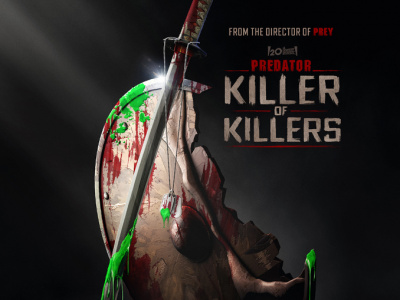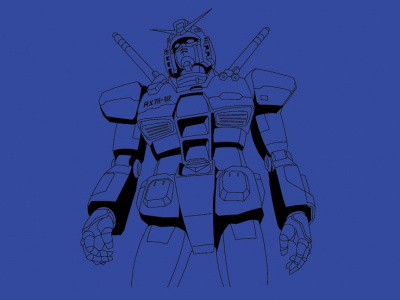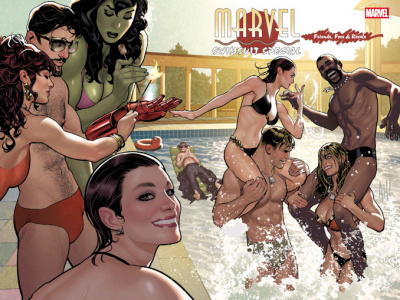A few weeks ago at the San Diego Comic-Con, we sat down with DC President and Publisher Paul Levitz (DC Senior Vice President Sales and Marketing Stephanie Fierman sat in) for our annual talk about the state of the comic business and DC's place in it. In Part 3, we talk about DC's CMX line. In Part 1, we talked about the state of the market for comic books and periodicals, and for Web and phone delivery of comics. In Part 2, we discussed DC's experiment with weekly comics. And in Part 4, we discuss the future of manga style work produced in the
We wanted to talk about CMX and manga in general. You announced eight acquisitions here at the show, which is the biggest expansion of that line since you started. Talk about the pace of that expansion and why it's faster.
Levitz: The key for me is that manga has established such a sizable and meaningful audience here, including a significant number of people who are not crossover readers for the rest of comics, that I think it's very good for DC to be in that business so we can reach those people.
We're trying to build CMX as quickly as we can tap into the right kinds of material. The Japanese publishing business of manga is a very complex one -- there are many different players with many different strengths. We're trying to build relationships with all the good houses and demonstrate to them that as a publisher who creates original material, we have creative advantages, we have marketing advantages, we have sensitivity to creative material that someone who's just repackaging material as their whole day's work might not have. We'll build at a pace as we can bring in the right stuff.
Obviously a company like Viz, which is a part of the same parent as two of the great publishing companies of manga in
Are there any common characteristics in your acquisitions either with regard to target demographics or with regard to the character of the editorial work?
Levitz: The common characteristics that we're focused in on is the range of manga that is fiction, that is compatible with what we see as one of the mainstream audiences for manga at this point, either the girls' titles or the men's action/adventure or science fiction/ fantasy stuff. We've looked at some titles that were nonfiction, we've looked at titles that were at a wider creative range. We haven't yet felt that we've had enough strength to do that in the market.
We probably have a more limited range of what would be at the far edge of R-rated to X-rated content than some publishers. We don't want to do material that is beyond the range we'd publish ourselves in our own lines. That affects the range that we look at as well. The Japanese culture is comfortable with any number of things in manga that American audiences are not necessarily comfortable with. We're probably not going to be the company that is going to push the limits to the extreme there.
We look at situations and titles where we feel the creators have a good reputation, either within the manga fan audience or within a broader audience if they've already had material published here. We try to look for stuff that's fun.
You said you want to maintain the same standards with regards to the adult nature of content for the CMX line as you do in the rest of your line. There was some editing in your titles, which aroused an otaku reaction. My first question is are you ever going to do that again, and then as a related question, have you changed your acquisition strategy as a result of your experience on that title?
Levitz: What happened on Tenjho Tenge is we did a series of changes in conjunction with the artist and the publisher of the material in
We've heard the fan reaction, the otaku reaction, and that they were unhappy about it. We're going to think hard if we're going to choose to have a series where they'd really like to see an unedited version and we don't feel comfortable publishing an unedited version or we don't feel an unedited version can get enough distribution before acquiring something like that. Part of the challenge is sometimes you're acquiring a series before it's finished. It may change over the course of its life and that will always be a certain amount of challenge.
You mentioned two target demos for the CMX line. Do you see the CMX brand as a big tent under which you can publish any kind of manga?
Levitz: We've experimented a couple of different ways with trade dress on it to differentiate between the tone of the titles and Stephanie can probably speak more intelligently about that.
Right now I think CMX is a very young brand, and its identity is in formation. If we're lucky and we build something that has real brand value, then you can start facing the challenge of what that brand means and what the boundaries are. The dominant players in the game here have had their brand expand to several different flavors. If that's the model, that may work for CMX as well.
Fierman: We got some feedback from our distribution channels that a homogeneous approach to trade dress on CMX wasn't doing us or the titles a service as it didn't help the customers differentiate the titles on the shelf among a very large number of choices. So we moved to maintaining a logo treatment that is instantly recognizable as CMX, but on the spines and the front and back covers, we are striving to reflect the personality of the title itself and to make indications where that's appropriate to help the reader determine whether it's a shojo or a shonen title.
So two types of trade dress to reflect those two groups?
Fierman: There's no template for it, aside from how we treat our brand, which is very important to us not just in CMX, but how we represent it on jackets and other assets in the main line. We are looking at every CMX title fresh in terms of how we dress and how we promote the title.







